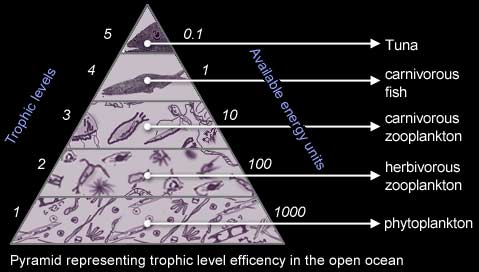Biosphere Contents
4. Interdependence
Energy transfer between trophic levels in the sea (as on land) is very inefficient
All life in the sea depends ultimately on the conversion of sunlight to stored chemical energy, mainly by phytoplankton. Phytoplankton are eaten by herbivores and the herbivores are eaten by carnivores, which in turn are often eaten by larger carnivores. Marine food chains are often longer than terrestrial ones, but as on land, the energy transfer that occurs between trophic levels is still very inefficient. When a carnivorous fish eats a smaller fish, most of the energy it absorbs is used for its metabolism, to hunt for more food, to avoid becoming a meal itself, for reproduction etc. Only a small fraction is used in growth, and not all of that growth will be available or digestable to organisms in the next trophic level. In natural marine ecosystems, 10% is usually taken as an average estimate for the efficiency of this energy transfer. Even in a mariculture system, where the farmer tries to maximize this energy conversion, food conversion ratios of 25% are considered very good.

What is a typical energy transfer efficiency between different trophic levels?